Abstract
Drought stress has detrimental effects on growth and yield of plants under arid or semi-arid environment. Because of their potential for modulating the redox status and changing the growth, performance and quality of plants, nano-scale materials are among the research interests of physiologists. This study evaluated the impacts of different concentrations (0, 10, 100, and 500 mg l−1) of nanosized (10–25 nm) titanium dioxide (TiO2) on growth, seed yield, photosynthetic pigment contents, the values of hydrogen peroxide (H2O2) and malondialdehyde (MDA), seed oil, and protein contents in Linum usitatissimum Linea (Linaceae) under sufficient and scarce water conditions. The results showed that application of nanoscale TiO2 at low concentration better improved the morphological and physiological traits of plant compared to other doses particularly under water scare conditions, leading to better plant performance. Enhanced chlorophyll and carotenoids contents were recorded in leaves of nano-anatase TiO2-treated plants under both normal and drought stress conditions, when compared to the control. The levels of H2O2 and MDA in plants exposed to nano TiO2 at 10 mgl−1 were lower than that of other treatments, therefore, lipid peroxidation was less pronounced in such plants. In both well watered and drought stress conditions, the highest values of seed oil and protein contents were obtained in plants treated with nano TiO2 at 100 mg l−1. Therefore, exogenous application of nano TiO2 particles at appropriate concentrations can ameliorate drought stress damage to Flax seed plants as well as increase the drought tolerance with remarkable improvement in physiological process.





Similar content being viewed by others
References
American Oil Chemists’ Society (1983) Official and tentative methods of the American Oil Chemists’ Society. Urbana, AOCS Champaign
Azimi R, Feizi H, Khajeh Hosseini M (2013) Can bulk and nanosized titanium dioxide particles improve seed germination features of wheatgrass (Agropyron desertorum). Not Sci Biol 5:325–331
Ben-Ahmed C, Ben-Rouina B, Sensoy S, Boukhris M, Ben-Abdallah F (2009) Changes in gas exchange, proline accumulation and antioxidative enzyme activities in three olive cultivars under contrasting water availability regimes. Environ Exp Bot 67:345–352
Benton JJ (1991) Kjeldahl method for nitrogen determination. Micro-Macro Publishing, Athens
Daun JK (1993) Oilseeds processing chapter D11 in grains and oilseeds, handling, marketing, processing, 4th edn. Canadian International Grains Institute, Winnipeg
Debasis C, Chatterjee J, Datta SK (2007) Oxidative stress and antioxidant activity as the basis of senescence in chrysanthemum florets. Plant Growth Regul 53:107–115
Dutta HK, Ram Mohan Rao DS, Singh H (1995) Response of linseed (Linum usitatissimum L.) to irrigation and nitrogen. Indian J Agron 40:130–131
Foltete AS, Masfaraud JF, Bigorgne E, Nahmani J, Chaurand P, Botta C, Labille J, Rose J, Ferard JF, Cotelle S (2011) Environmental impact of sunscreen nanomaterials: ecotoxicity and genotoxicity of altered TiO2 nanocomposites on Vicia faba. Environ Pollut 159:2515–2522
Frazier TP, Burklew CE, Zhang B (2014) Titanium dioxide nanoparticles affect the growth and microRNA expression of tobacco (Nicotiana tabacum). Funct Integr Genomic 14:75–83
Fu J, Huang B (2001) Involvement of antioxidants and lipid peroxidation in the adaptation of two cool-season grasses to localized drought stress. Environ Exp Bot 45:105–114
Ghorbanpour M, Hatami M (2015) Changes in growth, antioxidant defense system and major essential oils constituents of Pelargonium graveolens plant exposed to nano-scale silver and thidiazuron. Indian J Plant Phys 20:116–123
Ghosh M, Bandyopadhyay M, Mukherjee A (2010) Genotoxicity of titanium dioxide (TiO2) nanoparticles at two trophic levels: plant and human lymphocytes. Chemosphere 81:1253–1262
Green AG, Marshall DR (1981) Variation for oil quantity and quality in flaxseed. Aust J Agric Res 32:599–607
Hatami M, Ghorbanpour M (2014) Defense enzymes activity and biochemical variations of Pelargonium zonale in response to nanosilver particles and dark storage. Turk J Biol 38:130–139
Hatim M, Abbasi GQ (1994) Oil seed crops. In: Crop production. National Book Foundation, Islamabad, pp 366–369
Heath RL, Packer L (1968) Photoperoxidation in isolated chloroplasts: I. Kinetics and stoichiometry of fatty acid peroxidation. Arch Biochem Biophys 125:189–198
Hocking PJ, Randall PJ, Pinkerton A (1987) Mineral nutri-tion of linseed and fiber flax. Adv Agron 41:221–296
Khodakovskaya MV, Lahiani MH (2014) Nanoparticles and plants: fromtoxicity to activation of growth. In: Sahu SC, Casciano DA (eds) Handbook of nanotoxicology, nanomedicine and stem cell use in toxicology. Wiley, Chichester. doi:10.1002/9781118856017
Kiapour H, Moaveni P, Habibi D, Sani B (2015) Evaluation of the application of gibbrellic acid and titanium dioxide nanoparticles under drought stress on some traits of basil (Ocimum basilicum L.). Int J Agron Agric Res 6:138–150
Larue C, Khodja H, Herlin-Boime N, Brisset F, Flank AM, Fayard B, Chaillou S, Carrier M (2011) Investigation of titanium dioxide nanoparticles toxicity and uptake by plants. J Phys 304:012057
Laure C, Laurette J, Herlin-Boime N, Khodja H, Fayard B, Flank AM, Brisset F, Carriere M (2012) Accumulation, translocation and impact of TiO2 nano-particles in wheat (Triticum aestivum spp.): influence of diameter and crystal phase. Sci Total Environ 43:197–208
Lichtenthaler HK, Wellburn AR (1983) Determination of total carotenoids and chlorophylls a and b of leaf extracts in different solvents. Biochem Soc Trans 603:591–592
Liu CQ (2009) Biogeochemical processes and cycling of nutrients in the earth’s surface: Cycling of nutrients in soil–plant systems of Karstic environments, Southwest China. Science Press, Beijing
Lu CM, Zhang CY, Wen JQ, Wu GR (2002) Research on the effect of nanometer materials on germination and growth enhancement of Glycine max and its mechanism. Soybean Sci 21:68–171
Martin JH, Leonard WH, Stamp DL (1976) Principles of field crop production, 3rd edn. Macmillan, New York, pp 797–811
Mohammadi R, Maali-Amiri R, Abbasi A (2013) Effect of TiO2 nanoparticles on chickpea response to cold stress. Biol Trace Elem Res 152:403–410
Ozkur O, Ozdemir F, Bor M, Turkan I (2009) Physiochemical and antioxidant responses of the perennial xerophyte Capparis ovata Desf. to drought. Environ Exp Bot 66:487–492
Priyadarshini S, Deepesh B, Zaidi MGH, PardhaSaradhi P, Khanna PK, Arora S (2012) Silver nanoparticle-mediated enhancement in growth and antioxidant status of Brassica juncea. Appl Biochem Biotech 167:2225–2233
Racuciu M, Creanga D (2006) TMA-OH coated magnetic nanoparticles internalized in vegetal tissue. Rom J Phys 52:395–402
Rico CM, Majumdar S, Duarte-Gardea M, Peralta-Videa JR, Gardea-Torresdey JL (2011) Interaction of nanoparticles with edible plants and their possible implications in the food chain. J Agric Food Chem 59:3485–3498
Velikova V, Yordanov I, Edreva A (2000) Oxidative stress and some antioxidant systems in acid rain-treated bean plants: protective role of exogenous polyamines. Plant Sci 151:59–66
Wang ZY, Yu XL, Gao DM, Feng WQ, Xing BS, Li FM (2010) Effect of nanorutile TiO2 and multiwalled carbon nanotubes on the growth of Maize (Zea mays L.) seedlings and the relevant antioxidant response. Environ Sci 31:480–487
Yang F, Hong F, You W, Liu C, Gao F, Wu C, Yang P (2006) Influences of nanoanatase TiO2 on the nitrogen metabolism of growing spinach. Biol Trace Elem Res 110:179–190
Zhao XJ, Zhu ZQ, Wu XH (2005) Progress in high sensitization of hydrophilicity of the surface of TiO2. Mater Rev 11:102–105
Zheng L, Hong F, Lu S, Liu C (2005) Effect of nano-TiO2 on strength of naturally aged seeds and growth of spinach. Biol Trace Elem Res 105:83–91
Author information
Authors and Affiliations
Corresponding author
Rights and permissions
About this article
Cite this article
Aghdam, M.T.B., Mohammadi, H. & Ghorbanpour, M. Effects of nanoparticulate anatase titanium dioxide on physiological and biochemical performance of Linum usitatissimum (Linaceae) under well-watered and drought stress conditions. Braz. J. Bot 39, 139–146 (2016). https://doi.org/10.1007/s40415-015-0227-x
Received:
Accepted:
Published:
Issue Date:
DOI: https://doi.org/10.1007/s40415-015-0227-x




